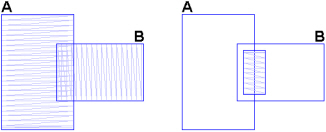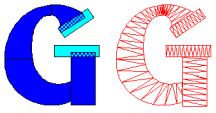Use overlaps to prevent pulling from creating gaps between blocks of stitches that have different stitch directions. Make a satin column or fill area slightly larger so that it lies over or under an adjacent block.
|
|
|
There are no overlaps so the end sections on the G will pull and leave gaps, as indicated by the arrows. |
|
|
|
Extending the arms of the G makes an overlap |
Underlay bars provide additional stitching to prevent a split at an overlap. Underlay bars are useful for stitching characters or SuperDesigns at large sizes or when wide sections of satin or fill are overlapped. They can also help on stretchy fabrics, such as wool knits.
Underlay bars are usually digitized as a small satin column placed where overlapping satin columns meet. An underlay bar is stitched before either of the overlapping columns. The Straight Column used for an underlay bar should have a stitch angle similar to the top stitches on the overlap.

On the left of the picture, column A is overlapping column B. If they were simply stitched out like this, a split is likely to appear along the line where they meet because of the pull caused by the stitches in column A. An underlay bar is shown on the right. Even if column A pulls the fabric to make a split, the split will not be seen because the stitches in the underlay bar will show through.

